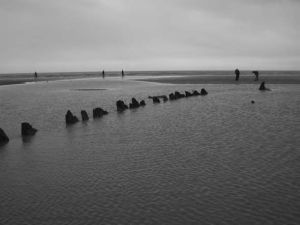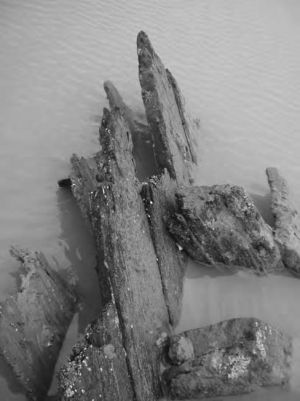|
In the last edition of Mollusc World in the Marine Recorders report 2005 the shipworm Lyrodus pedicellatus Quatrefages was recorded for Sandwich, Kent living in the rotting wooden ribs of a wrecked sailing ship. It is a species closely related to Teredo and is known as the Siamese shipworm. This species is first mentioned as food by Redi, who in a letter to his friend Megalotti, describes species of Teredo as being not only eatable, but excelling all shellfish, the oyster not excepted in its exquisite flavour. Nardo also praises it, and wonders why the Venetians, who call it ‘bisse del legno’, do not eat it ?. Jeffreys on the other hand says and I quote “I should, for my own part, be surprised that any person having a stomach could venture to try the experiment; for the smell of even a fresh shipworm is almost enough to make one sick”. Even M.S. Lovell in his Edible British Mollusks mentions it briefly. Anyway we know that today coastal people in Thailand have cultivated it in logs anchored in the sea for a very long time. Dr.Vagn Hanson, while Director of the Marine Station at Phuket, formed the opinion that this might have been one of the first examples of ‘sea farming’ in the world. The raw flesh has a good flavour but they say that it is important to collect shipworms which have been living in ‘Sam’ trees rather than in any old logs floating in the sea. The recipe is very simple. Make a scrambled egg mixture and add your shipworms. Fry until set and eat on buttered bread or toast. In Thailand, we are told, the dish can be improved by adding the eggs of the red ant, which are pea sized, and are found in pommelo and longan trees. Shipworms can also be pickled in vinegar or nam pla, Thai fish sauce. If you can’t get hold of this sauce one can substitute Anchovy, Worcestershire, Soy or even at a pinch Oyster sauce. ReferencesMollusc World 11 July 2006 British Conchology by J. G. Jeffreys Volume 111 Marine 1865 Edible British Mollusks by M.S.Lovell 1867 Seafood of South-East Asia by Alan Davidson 1976 Seafood by Rick Stein 1998 |
Photo credits: John Llewellyn Jones
|
Another beachcomber’s breakfast
Issue
12
Page
10

 1. Sandwich beach with skeleton of wrecked sailing ship
1. Sandwich beach with skeleton of wrecked sailing ship 2. Timber ribs with the burrowing shipworm Lyrodiscus pedicellatus
2. Timber ribs with the burrowing shipworm Lyrodiscus pedicellatus 3. More timber ribs with the burrowing shipworm Lyrodiscus pedicellatus
3. More timber ribs with the burrowing shipworm Lyrodiscus pedicellatus